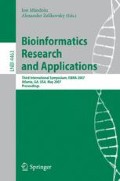Abstract
Transcription factor binding sites (TFBS) are often located in the upstream regions of genes and transcription factors (TFs) cause transcription regulation by binding at these locations. Predicting these binding sites is a difficult problem, and traditional methods have a high degree of false positives in their predictions. Comparative genomics data can help to improve motif predictions. In this paper, a new strategy is presented, which refines motif by taking the comparative genomics data into account. Tested with the help of both simulation data and biological data, we show that our method makes improved predictions. We also propose a new metric to score a motif profile. This score is biologically motivated and helps the algorithm in its predictions.
Access this chapter
Tax calculation will be finalised at checkout
Purchases are for personal use only
Preview
Unable to display preview. Download preview PDF.
References
Stormo, G.D.: DNA binding sites: representation and discovery. Bioinformatics 16(1), 16–23 (2000)
Werner, T.: Models for prediction and recognition of eukaryotic promoters. Mamm. Genome 10(2), 168–175 (1999)
Hughes, J.D., et al.: Computational identification of cis-regulatory elements associated with groups of functionally related genes in Saccharomyces cerevisiae. J. Mol. Biol. 296(5), 1205–1214 (2000)
Bailey, T.L., Elkan, C.: Fitting a mixture model by expectation maximization to discover motifs in biopolymers. In: Proc. Int. Conf. Intell. Syst. Mol. Biol., vol. 2, pp. 28–36 (1994)
Liu, X., Brutlag, D.L., Liu, J.S.: BioProspector: discovering conserved DNA motifs in upstream regulatory regions of co-expressed genes. In: Pac. Symp. Biocomput., pp. 127–138 (2001)
Liu, X.S., Brutlag, D.L., Liu, J.S.: An algorithm for finding protein-DNA binding sites with applications to chromatin-immunoprecipitation microarray experiments. Nat. Biotechnol. 20(8), 835–839 (2002)
Sinha, S., Tompa, M.: YMF: A program for discovery of novel transcription factor binding sites by statistical overrepresentation. Nucleic Acids Res. 31(13), 3586–3588 (2003)
Pavesi, G., et al.: Weeder Web: discovery of transcription factor binding sites in a set of sequences from co-regulated genes. Nucleic Acids Res. 32(Web Server issue), W199–203 (2004)
Hertz, G.Z., Stormo, G.D.: Identifying DNA and protein patterns with statistically significant alignments of multiple sequences. Bioinformatics 15(7-8), 563–577 (1999)
Friberg, M., von Rohr, P., Gonnet, G.: Scoring functions for transcription factor binding site prediction. BMC Bioinformatics 6, 84 (2005)
Jensen, S.T., Liu, J.S.: BioOptimizer: a Bayesian scoring function approach to motif discovery. Bioinformatics 20(10), 1557–1564 (2004)
MacIsaac, K.D., Fraenkel, E.: Practical strategies for discovering regulatory DNA sequence motifs. PLoS Comput. Biol. 2(4), e36 (2006)
Sandve, G.K., Drablos, F.: A survey of motif discovery methods in an integrated framework. Biol. Direct 1, 11 (2006)
Guha Thakurta, D.: Computational identification of transcriptional regulatory elements in DNA sequence. Nucleic Acids Res. 34(12), 3585–3598 (2006)
van Nimwegen, E., et al.: Probabilistic clustering of sequences: inferring new bacterial regulons by comparative genomics. Proc. Natl. Acad. Sci. U S A 99(11), 7323–7328 (2002)
Xie, X., et al.: Systematic discovery of regulatory motifs in human promoters and 3’ UTRs by comparison of several mammals. Nature 434(7031), 338–345 (2005)
Gertz, J., et al.: Discovery, validation, and genetic dissection of transcription factor binding sites by comparative and functional genomics. Genome Res. 15(8), 1145–1152 (2005)
Gertz, J., Fay, J.C., Cohen, B.A.: Phylogeny based discovery of regulatory elements. BMC Bioinformatics 7, 266 (2006)
Blanchette, M., Tompa, M.: Discovery of regulatory elements by a computational method for phylogenetic footprinting. Genome Res. 12(5), 739–748 (2002)
Moses, A.M., Chiang, D.Y., Eisen, M.B.: Phylogenetic motif detection by expectation-maximization on evolutionary mixtures. In: Pac. Symp. Biocomput. 2004, pp. 324–335 (2004)
Wang, T., Stormo, G.D.: Combining phylogenetic data with co-regulated genes to identify regulatory motifs. Bioinformatics 19(18), 2369–2380 (2003)
Sinha, S., Blanchette, M., Tompa, M.: PhyME: a probabilistic algorithm for finding motifs in sets of orthologous sequences. BMC Bioinformatics 5, 170 (2004)
Siddharthan, R., Siggia, E.D., van Nimwegen, E.: PhyloGibbs: a Gibbs sampling motif finder that incorporates phylogeny. PLoS Comput. Biol. 1(7), e67 (2005)
Comin, M., Parida, L.: Subtle Motif Discovery for Detection of DNA regulatory sites. In: Asia Pacific Bioinformatics Conference (APBC2007), Hong Kong (2007)
Tompa, M., et al.: Assessing computational tools for the discovery of transcription factor binding sites. Nat. Biotechnol. 23(1), 137–144 (2005)
Chu, S., et al.: The transcriptional program of sporulation in budding yeast. Science 282(5389), 699–705 (1998)
Narasimhan, C., LoCascio, P., Uberbacher, E.: Background rareness-based iterative multiple sequence alignment algorithm for regulatory element detection. Bioinformatics 19(15), 1952–1963 (2003)
Mitchell, A.P.: Control of meiotic gene expression in Saccharomyces cerevisiae. Microbiol. Rev. 58(1), 56–70 (1994)
Rubin-Bejerano, I., et al.: Induction of meiosis in Saccharomyces cerevisiae depends on conversion of the transcriptional represssor Ume6 to a positive regulator by its regulated association with the transcriptional activator Ime1. Mol. Cell Biol. 16(5), 2518–2526 (1996)
Kellis, M., et al.: Sequencing and comparison of yeast species to identify genes and regulatory elements. Nature 423(6937), 241–254 (2003)
Author information
Authors and Affiliations
Editor information
Rights and permissions
Copyright information
© 2007 Springer-Verlag Berlin Heidelberg
About this paper
Cite this paper
Zeng, E., Narasimhan, G. (2007). Enhancing Motif Refinement by Incorporating Comparative Genomics Data. In: Măndoiu, I., Zelikovsky, A. (eds) Bioinformatics Research and Applications. ISBRA 2007. Lecture Notes in Computer Science(), vol 4463. Springer, Berlin, Heidelberg. https://doi.org/10.1007/978-3-540-72031-7_30
Download citation
DOI: https://doi.org/10.1007/978-3-540-72031-7_30
Publisher Name: Springer, Berlin, Heidelberg
Print ISBN: 978-3-540-72030-0
Online ISBN: 978-3-540-72031-7
eBook Packages: Computer ScienceComputer Science (R0)

